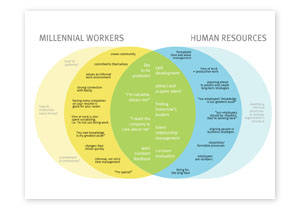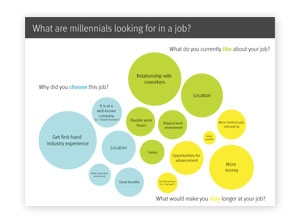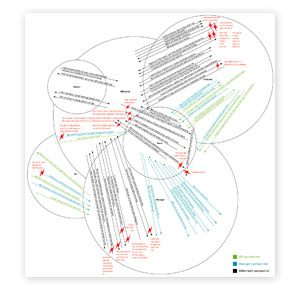Findings
Interests Model | Surveys | Contextual Inquiries | Needs Validation
Interests Model
Since our background research covered the three main topics of millennials, human capital management, and social networking, we wanted to compile all our insights into a model that would serve as a guide and an inspirational tool during the design phase of our project. In particular, we were interested in seeing how our insights matched the interests of millennial workers, of human resources, or of both.
The model (figure 1) clearly shows that there are many conflicting interests between the goals of human resources and the interests of millennial workers. The main function of HR in an organization is to be able to handle employees like a resource as much as possible, similar to other resources (such as materials) that can be manipulated in order to maximize output. Conversely, millennials want to be recognized for who they are and value the freedom to manage their own time and work environment.
Although the conflicting interests outnumber the complementary interests, the model suggests opportunities that we can pursue with our project, namely that millennials want to be recognized for their talents and appreciate constant feedback, which is in line with the goal of enterprises to identify tomorrow’s leaders and develop their talents.
Top ^Survey Results
When the survey results were compiled and analyzed, three important insights stood out from the data.
1) Motivating and Retaining Young Talent
A key question that we were interested in was what factors can motivate and retain young talent. In the survey, we asked millennials what would encourage them to stay longer at their current job, figure 2 to the right shows the top responses.
2) Tendency to "job hop"
Prior to the survey, we discovered some sources from our literature review which stated that the millennial generation shows a greater tendency to job hop. We wanted to confirm this finding with our respondents. In response to the question, “how long do you plan to stay at the company”, slightly less than 40% of the participants had plans to switch their job within the next two years. More than 70% of the responses indicated that they will try to get a new job within 5 years.
3) Relationship with manager
A of the the literature that was read noted that millennials prefer a much more informal relationship with their manager than previous generations. In order to further explore this area, the survey asked both what the individuals current relationship is with their manager, and what their ideal relationship would be with their manager. The results can be seen in figure 3 to the right.
It was interesting to note that in our results, millennials weren’t interested in a completely informal relationship with their manager. People tend to assume that this new generation prefers a close and informal relationship with their manager. Our survey, however, suggests that the relationship between the millennial and their manager must find a delicate balance between being entirely informal and being too formal. In our survey, we also asked the participants about their relationship with their coworkers, and if they engage in social activities with them outside of work. Eighty-four percent of the respondents reported to spending time with coworkers outside of work, with the top two activities being “drinks after work” and “company-sponsored events”.
Top ^Contextual Inquires
A majority of the findings from our contextual inquiries can be found in the models present on the right hand side of the contextual inquiries page
After reviewing the three consolidated models divided into roles, we saw that the most useful insights were arising from the cultural models. We thus decided to consolidate the three cultural models (millennials, HR, manager) into one combined consolidated model in order to gain a better understanding of the interplay between our three main target user groups (see figure 4). We have identified four important insights that will assist and guide us in the design phase:
1. Conflict between personal development goals and company business goals
Companies are dedicated to pursuing the maximization of profit. In order to accomplish this goal, they need to develop their talent. However, the development of talent is limited by a constrained budget. For a successful company, it is vital that this interplay between profit and talent development finds a delicate balance between the short-term cost and long-term returns.
It is challenging but most beneficial if a company is able to align the personal development goals of the employees with the larger company goals. By doing this, the company will not only enjoy an influx and retention of talent, but also in the long term, they will have an overall improved workforce and be able to establish their competitive advantages.
2. Processes mandated by HR lack personal communication
Human resource processes and tools are implemented company-wide and are mandatory work for all employees, including managers and millennials. These processes are necessary, and are useful in terms of being able to organize information in a structured way.
However, these processes lack feelings of personalization and customization of communication. It is clear from our models that millennials prefer personal correspondence, and are not very excited about all of the paperwork issued from HR.
Our findings suggest that HR is very objective-oriented. They are focused on gathering the necessary information, getting the paperwork correctly filled out, and following all the required procedures. Although this attitude is efficient in solving the tasks at hand, it has become removed from the needs of the employees.
3. Family structure or lack thereof may be another influencer on employees’ work place behavior.
Although we are finding generational traits that are influencing the behavior of the millennials, it is also important to note that behaviors are greatly influenced by the life stage of the individual. For example, the majority of millennials have not begun a family. When compared to older generations, this fact has a significant impact on both personal and work life.
During our contextual inquiries, we found that many millennials felt that company-organized social events were directed more towards employees with families. Therefore, the millennials felt excluded from such events. Such differences in life stages among employees becomes a deterrent for bonding as there is a natural tendency to socialize with people based on similarities.
Furthermore, since a majority of millennials has not started a family yet, their work hours may be more flexible than those of older generations whose work hours are constrained by family responsibilities. It is important to note, however, that this may change as the millennial generation grows older and transitions more into a family-oriented lifestyle.
4. Team as a resource provider and its implicit influence on millennials.
When at work, millennials have the most interaction with their team members. Because of this typical daily interaction, the team tends to become an unofficial resource provider to the new workers. When the millennial has work-related questions or is simply trying to “learn the ropes” of the new company, it is easy for them to turn to and ask the team. Not only is this type of resource essential for the new hire, but it helps improve relationships and team bonding.
It is also vital to remember that each team has its own set of norms. These unwritten rules are vital to becoming a beneficial, functioning member of the team, but are often very difficult for a newcomer to learn. These rules are typically learned gradually on a trial and error basis.
Top ^Needs Validation
The scenarios which received the most positive feedback were ‘Cross-team contacts’, ‘Informal responsibilities’ and ‘Training recommendations’. The least desirable scenarios were those with the themes of ‘Similar interests’, ‘Assigning mentors’ and ‘Personal feedback’. On the one hand, our participants liked the ability to form new connections to colleagues outside of their teams through co-workers they already knew in order to find answers to their questions. Furthermore, having a system to look up who to ask rather than a pure knowledge storage solution was favored by our participants. On the other hand, our participants had difficulties identifying with the needs of a manager when looking for a mentor and voiced multiple concerns about getting feedback from their peers since this could possibly lead to plotting and manipulation among co-workers (i.e. company politics) when trying to get good feedback in order to receive a bonus. Furthermore, the idea of work and leisure separation, which we already encountered with some users during our previous research reemerged during our needs validation as well, thus resulting in less positive feedback for the scenario which addresses the need to make connections with co-workers based on similar personal interests.
After we had ranked the most important needs for our design, we needed to discover the overall underlying structure to each of the solutions depicted in the scenarios in order to abstract them to a more general solution which addresses all of those needs. For this purpose, we devised a 5 step model of knowledge retrieval through people in a work setting. The five steps are:
- What are you looking for?
- Who has that knowledge?
- How is that person connected to that knowledge?
- How are you connected to the person?
- How can you communicate with that person?
This model acts as a way of conceptually separating our design based on the cognitive steps that an employee executes when trying to retrieve knowledge. From this model, we proceeded to create the overall workflow of our solution from which we then started our sketching and wireframing process.






